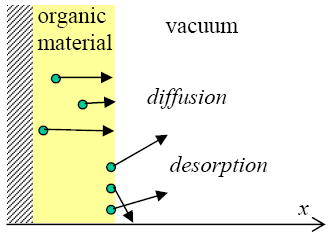Table of contents
- Introduction
- Implemented physics
- References
Introduction
The presence of contamination can degrade the performance of spacecraft hardware. Sources of contamination are outgassing, thrusters, vents, dumps, material erosion etc. In the SPENVIS contamination tool only outgassing is considered which is often the dominant source.
Material outgassing can be approached as a desorption combined with a diffusion for bulk
contaminant species that can be either initially present components (e.g. water, solvents, additives, ...), or decomposition products created by exposure to solar radiation or other environments.

|
|
Figure 1. Outgassing: diffusion followed by desorption (from Roussel et al., 2009).
|
If an outgassed molecule impacts a surface, it may stick to the surface and be re-emitted following a Lambertian distribution law (since the process is difuse) after it has acquired enough energy to escape the electrical attraction to the surface. The average residence time on the surface is therefore related to the surface temperature. The surface accomodation is usually described by a sticking coefficient S, which is defined as the probability that a molecule, colliding with a surface, stays on that surface before thermal re-evaporation of that molecule occurs (see ECSS-Q-ST-70-02C). Migrations on surfaces are very complex and not included in the SPENVIS contamination tool.
Implemented physics
Outgassing rate
Material outgassing is accompanied by mass loss of the source which can be described by reaction rate kinetics.
The rate of mass loss, whether due to decomposition, desorption, diffusion or evaporation is is a
function of the instantaneous interacting mass m and is generally described as:

with n the exponent giving the order of the reaction and c the proportionality constant which is temperature dependent.
In the SPENVIS contamination tool we consider two cases for the outgassing: a zero order reaction (n=0) and a first order reaction (n=1).
In the first case the rate is given by:

with Ps the vapour pressure in hPa, M the molecular mass in amu and T the temperature in K.
Assuming the Arrhenius relation to be valid for the temperature dependency, the first order rate is given by:

with τ the residence time of the molecule on the surface in s, τ0 the oscillation period of the molecule on the surface in s, k a constant in 1/K, T the temperature in K and T0 the reference temperature in K. The reference temperature is usually 298 K. Scialdone (1981) reports oscillation times
on the order of 10–14 to 10–12 s, with 10–13 s being average. Conversely, Naumann (1973) reports an oscillation period for water of 10–16 s. For most applications, the actual value of τ0 is not that critical as most outgassed contaminants will have a very short residence time on all but cryogenically
cooled surfaces. For example, water, with an activation energy of ~ 11 kcal/mole, has a residence
time of 1 × 1011 s on a surface at 100 K, but only 10 ms on a 300 K surface. If a
contaminant molecule has a residence time long in comparison to the life of the mission, it can be
assumed to remain permanently. We stop the integration when the integration step becomes larger than half the value of τ.
The rates are expressed in mass per unit time and unit surface area (g/cm2/s].
Transport between the surfaces
The transport is simulated as collissionless. The incident mass rate on a surface j is given by,

with Sj the sticking coefficient of the molecule on surface j, Fij the view factor between surface i and j which are computed by the View Factor tool and dmi/dt the emission rate from surface i.
Re-emission rate
For the re-emission of a molecule after deposit on a surface we apply the first order rate.
References
ECSS-Q-ST-70-02C
ECSS-E-ST-10-04C, p. 74-76, and p. 184-189.
Naumann, R. J., "Contamination Assessment and Control in Scientific Satellites", NASA TN-D-
7433, October, 1973.
Roussel, J-F, Faye, D., et al., "A new frontier for contamination: reaching the molecules", ISME, 2009.
Scialdone, J. J., "Characterization of the Outgassing of Spacecraft Materials", Society of Photo-
Optical Instrumentation Engineers, Shuttle Optical Environment, Vol. 287, pp. 2 - 9, 1981.
Last update: Mon, 12 Mar 2018





